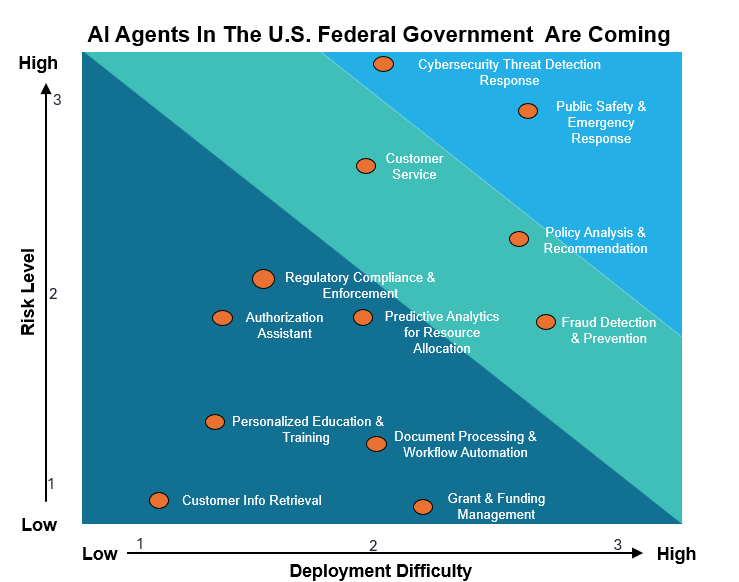US Federal Workforce Layoffs: Can AI Agents Step In?
US federal government organizations are facing massive budget cuts, contract cancellations, and, yes, layoffs. Those facing this new reality are deeply affected, losing colleagues they’ve worked with for decades and valuable partnerships that help them execute. Despite the challenges, they must find a way to continue with their mission. The constant drumbeat: achieving greater outcomes with fewer resources. What might be able to help?
Mission leaders are looking to emerging AI agent technologies to offer a pathway to meet this challenge. These automations can perceive their environment, make decisions, and take actions. By deploying AI agents, agencies can automate complex tasks, enhance efficiency, and deliver more impactful services without a proportional increase in personnel or expenditure. Agents won’t be able to replace valuable members of your team, but they can help you get key mission tasks complete and bolster the remaining workforce.
Success lies in identifying the right applications and thoughtfully integrating these intelligent assistants into existing workflows. But beware: Silent substitutes can have loud consequences. The risks of poor implementation, oversight, or design of AI agents in government are high. For example, biased training data and opaque AI deployments for fraud detection could disproportionately affect vulnerable populations. How do you go about selecting the right use cases?
US federal agencies are no strangers to AI use cases; in fact, federal inventories of AI use cases are vast. Much of what has been done is predictive AI, with few generative examples even for workforce productivity. The spectrum of potential use cases for AI agents across the federal landscape is also promising. AI agents have the potential to provide 24/7 customer support, answer inquiries, guide individuals through complex processes, and direct them to the necessary resources. This not only enhances customer experience (for constituents, citizens, visitors, residents, etc.) but also frees up human agents to handle more intricate or sensitive cases.
AI agents can also bolster security. Their ability to analyze massive datasets makes them adept at detecting and preventing fraudulent activities and flagging potential violations for human review. The high-impact area of cybersecurity also stands to benefit, with AI agents offering real-time threat detection. In critical areas such as public safety and emergency response, AI agents can analyze real-time data to provide insights, potentially leading to safer communities and more effective crisis management.
Beyond customer-facing and security applications, AI agents can streamline internal government operations. From automating the often-cumbersome processes of grant and funding management to intelligently processing documents and automating workflows, these agents can reduce administrative burdens and accelerate timelines. In the longer term, their analytical capabilities extend to policy analysis, where they can sift through complex data to provide valuable insights for policymakers. As AI advances in the federal government, expect to see personalized education and training programs powered by AI agents to enhance employee skill development in a cost-effective and tailored manner. By strategically embracing these diverse applications, the US federal government can leverage the power of AI agents to do more with less, ultimately better serving the American people. The goal? Aim for low risk and high value until you’ve gained experience.
Here is Forrester’s analysis of the top 11 AI agent use cases for the US federal government:

The next generation of AI agents is defined by autonomous goal setting, dynamic reasoning, real-time learning, enhanced model control, and the ability to execute complex actions. Widespread deployment will be tempered, however, by a significant gap between these technological capabilities and organizational trust. Critical design challenges, including explainability, bias mitigation, reasoning guardrails, and robust data governance, must be addressed. Ambition must also be tempered with reality.
History will repeat itself. AI agents will take longer than we think to be productive, just like the internet, mobile, and cloud, but finding the right use case has never been more critical. It’s not like the “cloud,” where you know what you are going to get but just in a different way. Finding the app that drives value is the most important thing. For mission leader, the imperative is clear: Embrace the AI agent movement, understand both its transformative potential and inherent challenges, and actively develop the skills to become creators of this powerful new automation. Automation will be your path to your agentic future. This will be one of the most meaningful steps that your agencies can take now.
If you are a US government mission, business, or technical leader looking to get savvy on AI and automation for government agencies, Forrester is hosting a meeting on May 14 for clients and prospects alike. This session will feature me, Craig Le Clair, in a discussion of AI agents for US federal agencies, as well as our CTO, Michael Facemire, going step by step through how Forrester built its own genAI tool. If you’re interested in joining your peers, register now!
